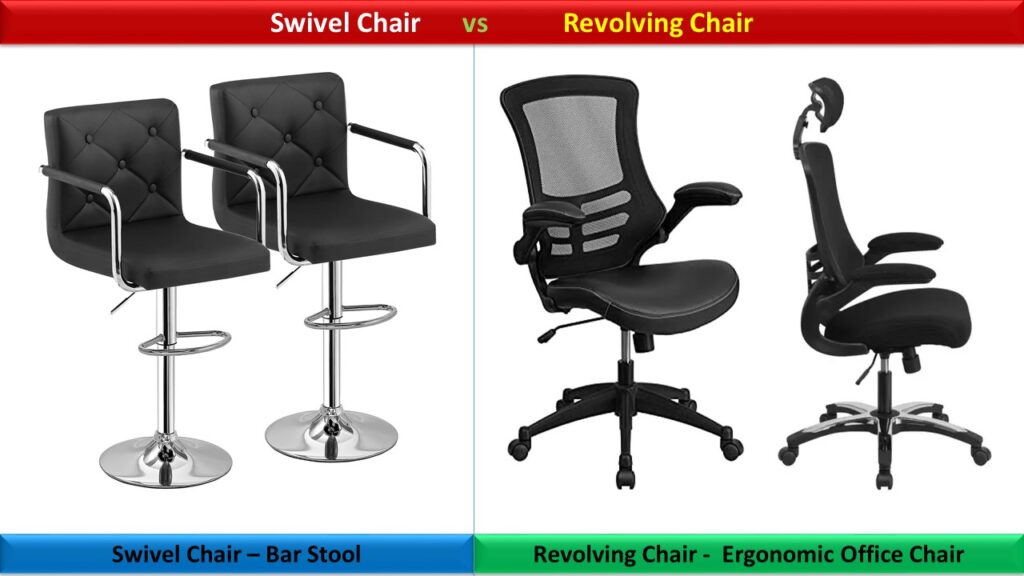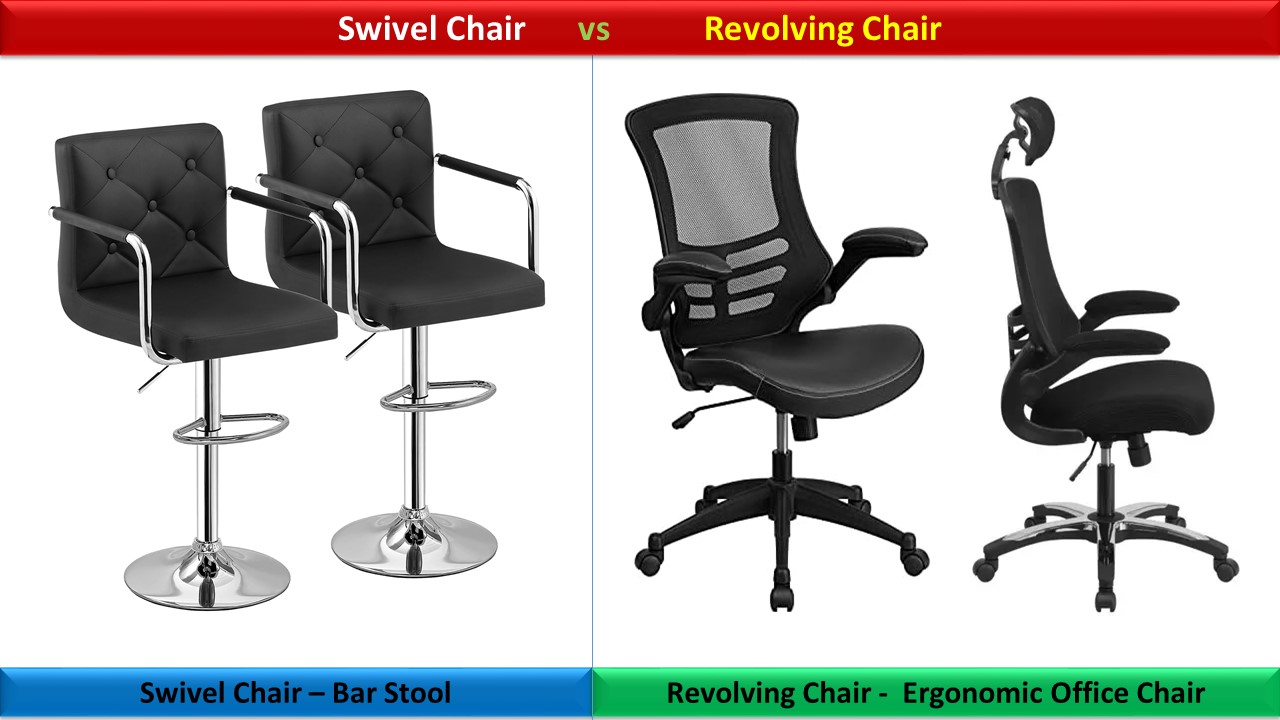In everyday language, the terms “swivel chair” vs “revolving chair” are often used interchangeably to refer to chairs that can rotate or turn. However, there isn’t a strict, universally accepted distinction between the two terms, and their usage can vary regionally and contextually.
Swivel Chair vs Revolving Chair
That said, there is a subtle difference that some people may use to distinguish between the two:
Swivel Chair:
A swivel chair is typically a chair with a single central point of rotation at its base, allowing it to pivot or rotate 360 degrees horizontally. This means you can turn the chair left or right while keeping the chair’s position fixed in terms of height.
Swivel chairs are often used in office settings, at desks, and in other situations where easy movement and access to different parts of a workspace are required.
Revolving Chair:
A revolving chair, on the other hand, may imply a chair that not only swivels horizontally but also has the capability to adjust in height. In this case, “revolving” suggests both horizontal rotation and vertical movement.
Revolving chairs are often associated with chairs that have adjustable height mechanisms, such as office chairs with gas-lift systems.
In practical terms, the choice between “swivel chair” and “revolving chair” may come down to personal preference or regional terminology. Both terms are used, and people will generally understand the concept regardless of which term you use. If you want to be more precise, you can describe the chair’s features in detail, such as mentioning that it swivels and has adjustable height if applicable.
The Terms Swivel vs Revolve
“Swivel” and “revolve” are two English words that are related but have distinct meanings:
Swivel:
- Definition: To swivel means to rotate or turn around a central point, often horizontally.
- Usage: Swiveling involves a circular or pivoting motion around a fixed axis. It is commonly used to describe the action of chairs, stools, or other objects that can rotate horizontally while maintaining their position in terms of height. For example, a swivel chair allows you to turn left or right while sitting in one place.
Revolve:
- Definition: To revolve means to move in a circular or orbiting path around a central point, axis, or object.
- Usage: Revolving typically refers to objects or celestial bodies that move in a circular motion around a central point or axis. For instance, the Earth revolves around the sun, and planets in our solar system revolve in their orbits. In a different context, “revolve” can also be used to describe objects that rotate around a central axis but may not necessarily be in a horizontal plane, such as a revolving door in a building.
In summary, while both “swivel” and “revolve” involve some form of rotational movement, “swivel” usually refers to horizontal rotation around a fixed point, often at or near ground level, while “revolve” refers to circular movement around a central point or axis, which can occur in various planes and orientations.

Difference Between Swivel Chair vs Revolving Chair
Here’s a tabular comparison of revolving chairs and swivel chairs, including examples of each:
| Feature | Revolving Chair | Swivel Chair |
| Horizontal Rotation | Rotates or swivels horizontally, often 360 degrees. | Rotates or swivels horizontally, typically 360 degrees. |
| Vertical Adjustment | Often includes a gas-lift mechanism to adjust height. | Typically does not include height adjustment features. |
| Common Use Cases | Commonly used in office settings, computer desks, and workstations. | Found in various settings, including offices, homes, and dining areas. |
| Comfort and Support | May offer ergonomic features like lumbar support, headrests, and armrests. | Range from basic designs to more comfortable and luxurious options. |
| Examples | – Office chairs with height adjustment (e.g., ergonomic task chairs). | – Bar stools that rotate but don’t have height adjustment. |
| – Executive office chairs with height adjustment. | – Dining chairs with swivel bases for easy access. |
Keep in mind that the terminology can vary, and in some regions or contexts, the terms “revolving chair” and “swivel chair” might be used interchangeably to describe chairs that rotate horizontally. The key distinction is typically the presence or absence of height adjustment features, with revolving chairs often having this feature while swivel chairs usually do not.
Live Examples of Swivel Chair vs Revolving Chair
Swivel Chair Example:
Office Swivel Chair:
This is a common example of a swivel chair. It typically has a central base with wheels or a swivel mechanism that allows you to rotate the chair horizontally while keeping it at a fixed height. These chairs are used in office settings to provide mobility and flexibility to users while working at a desk.
Bar Stool with Swivel:
Many bar stools have a swivel feature, enabling people to turn and face different directions at a bar or countertop without needing to move the entire stool. You can often find these in bars, restaurants, or kitchen islands.
Revolving Chair Example:
Executive Office Revolving Chair:
An executive office chair with a revolving feature allows for both horizontal rotation and height adjustment. These chairs often have a gas-lift mechanism that lets you adjust the chair’s height to your preference while still being able to swivel or rotate.

Revolving Chair in a Library:
In some libraries or reading rooms, you may find chairs that not only swivel but also have a height adjustment feature. These chairs provide comfort for readers who may want to change their seating position and adjust the chair to the right height for reading.
Revolving Chair in a Meeting Room:
Meeting room chairs often come with revolving features. They allow participants to swivel to face different directions or people in the room while maintaining an appropriate height for the meeting table.
These examples illustrate the functional differences between swivel and revolving chairs, with revolving chairs typically having both horizontal rotation and height adjustment capabilities.
Pros and Cons
These pros and cons offer an overview of the advantages and potential limitations associated with using a swivel chair and revolving chair. The suitability of a swivel /revolving chair depends on the specific needs and preferences of the user and the context in which it will be used.
Revolving Chair
| Pros of Revolving Chair | Cons of Revolving Chair |
| 1. Adjustable Height: Revolving chairs often come with height adjustment mechanisms, allowing users to customize the chair’s height for comfort. | 1. Cost: High-quality revolving chairs with advanced features can be expensive, making them less accessible for some consumers. |
| 2. Flexibility: They provide both horizontal rotation and vertical adjustment, offering users flexibility in their seating position. | 2. Maintenance: The moving parts and mechanisms in revolving chairs may require maintenance and occasional repairs over time. |
| 3. Comfort: Many revolving chairs are designed with ergonomic features, such as lumbar support and padded seats, to enhance user comfort during extended periods of use. | 3. Space: Revolving chairs with a wide range of motion may require more space compared to stationary chairs. |
| 4. Versatility: Suitable for various settings, including offices, meeting rooms, and home offices, due to their adaptability and comfort. | 4. Assembly: Some revolving chairs may require assembly upon purchase, which can be time-consuming or challenging for some individuals. |
| 5. Improved Accessibility: Revolving chairs with wheels make it easy to move around a workspace without getting up, promoting efficiency and productivity. | 5. Durability: The longevity of revolving chairs may vary depending on their quality and construction; lower-quality chairs may wear out faster. |
| 6. Aesthetics: They are available in various styles and materials, making it possible to choose a chair that complements the overall decor of a room. | 6. Weight Limit: Some revolving chairs may have weight limits, so they may not be suitable for all individuals. |
Swivel Chair
| Pros of Swivel Chair | Cons of Swivel Chair |
| 1. 360-Degree Rotation: Swivel chairs can rotate horizontally in a full circle, allowing users to easily change their orientation without getting up. | 1. Lack of Height Adjustment: Most swivel chairs do not have height adjustment features, which can limit customization for users of different heights. |
| 2. Mobility: Swivel chairs with wheels provide excellent mobility, making them suitable for office workstations and tasks that require frequent movement. | 2. Limited Ergonomic Support: Basic swivel chairs may lack advanced ergonomic features such as lumbar support or adjustable armrests. |
| 3. Space-Saving: They typically have a compact design, making them suitable for small spaces where a larger chair might not fit. | 3. Fixed Height: The fixed height of swivel chairs may not be ideal for tasks that require precise height adjustments, such as drafting or certain office work. |
| 4. Affordability: Swivel chairs are often more budget-friendly than fully adjustable ergonomic office chairs. | 4. Reduced Comfort: Some swivel chairs, especially those without padding or ergonomic design, may be less comfortable for extended periods of sitting. |
| 5. Ease of Use: They are user-friendly and require minimal effort to rotate, making them suitable for quick changes in orientation. | 5. Limited Versatility: Swivel chairs may not be as versatile as chairs with height adjustment, making them less suitable for tasks that require precise customization. |
| 6. Variety of Styles: Swivel chairs come in a wide range of styles, colors, and materials, allowing users to choose a chair that matches their decor preferences. | 6. Durability: The durability of swivel chairs can vary, with some budget options having shorter lifespans and less robust construction. |
Final Thoughts
In summary, the terms “swivel chair” and “revolving chair” are often used interchangeably in everyday language, but they can have subtle distinctions:
A swivel chair is typically a chair that can rotate or pivot horizontally around a central point, allowing the user to turn left or right while staying at the same height. Swivel chairs are commonly used for easy movement and accessibility in various settings.
A revolving chair, on the other hand, is a broader term that can refer to a chair that rotates or moves in a circular or orbital path around a central point or axis. In some contexts, it may imply a chair with not only horizontal rotation but also an adjustable height feature.
However, the specific usage and distinction between these terms can vary regionally and contextually, and in practical terms, both types of chairs offer rotational functionality.
Read Also: Low Cost Material for Furniture Fabrication – All in Internet

